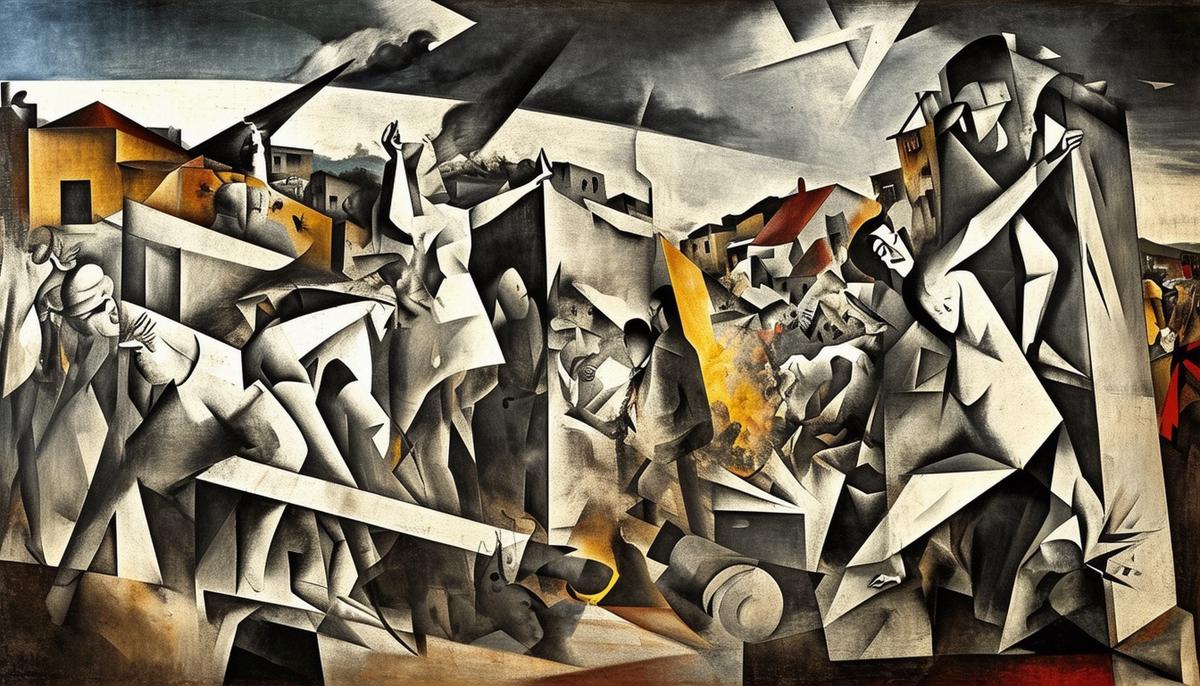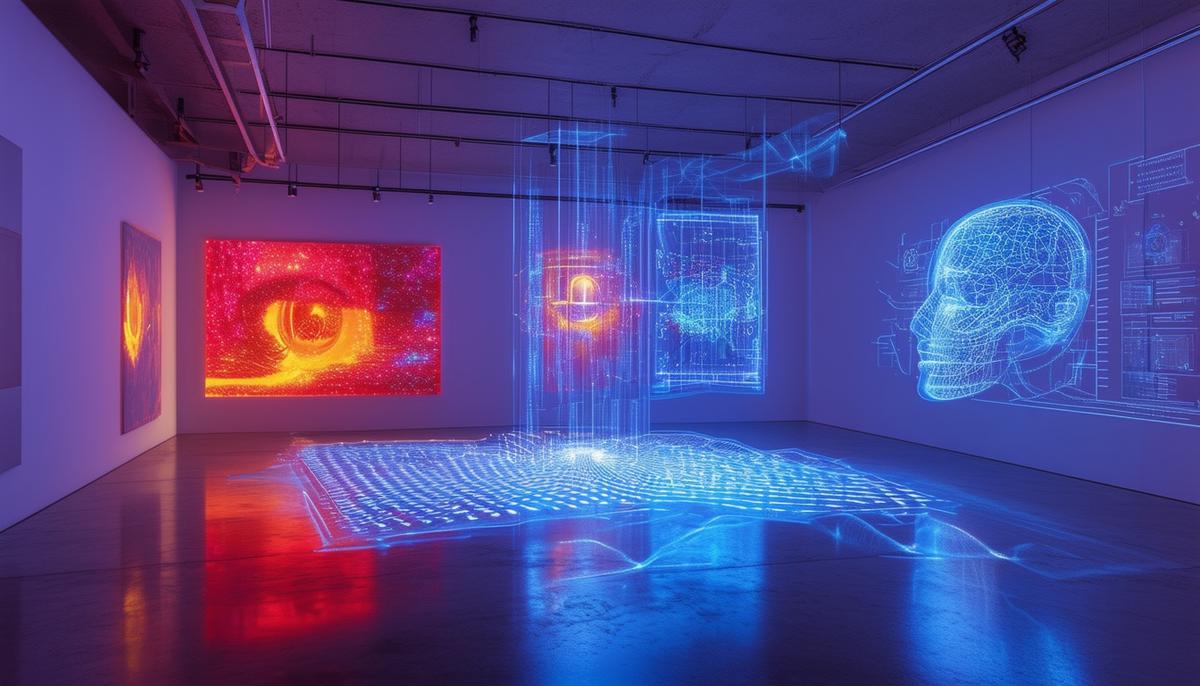
Digital and Sustainable Art
As we examine the contemporary art scene of 2024, a significant shift towards digital and sustainable art forms is evident. The interplay of technology-driven aesthetic experiences and a strong ecological conscience is shaping the landscape. Digital art has grown beyond the initial fascination with novelty, becoming a domain where virtual reality and artificial intelligence are collaborators in the creative process. Artists like Sebastiaan Knot exemplify creatives who harmoniously blend code with canvas.
Sustainability also carries deep artistic and ecological resonances. More artists are consciously using recycled materials and embracing themes that spotlight environmental narratives. This convergence of art with activism introduces a spectrum of color, emotion, and message that is hard to overlook. Guillaume Pépy's environmental photography captures pressing global concerns, transforming each piece into a powerful catalyst for ecological discourse.
The fusion of technology and environmental mindfulness presents a refreshing evolution in the art world. Artists are integrating organic materials to comment on critical issues such as colonization and ancestral legacies, knitting a complex dialogue between our histories and modern narratives around land use and climate challenges. Delcy Morelos and Mary Manning are notable artists whose works interrogate nuanced ecological stories through innovative material choices.
Bridging both these themes is a collective consciousness about consumption and its impact on the planet. This pivot to sustainability is prevalent in material selection and the narrative structures and symbolic meanings in contemporary art. Curator Marina Isgro underscores an intriguing trend of blending historical artistic narratives with contemporary issues, highlighting a deep connectivity across eras through the medium of art.
As data becomes more integral to art production, digital trends such as augmented reality installations take viewers on mesmerizing journeys that intertwine the tangible with the virtual. This synchronization crafts spaces where viewers can experience art in multi-dimensional overlays, bending their perceptions of art, audience, and shared spaces.
Parallel to this digital ascendancy, there's a passionate renewal in crafting art with a conscience. By covering both physical and ethical landscapes, these trends encapsulate a deeper societal engagement with our collective future, ensuring that every stroke and pixel resonates more impactfully with the urgencies of our time.
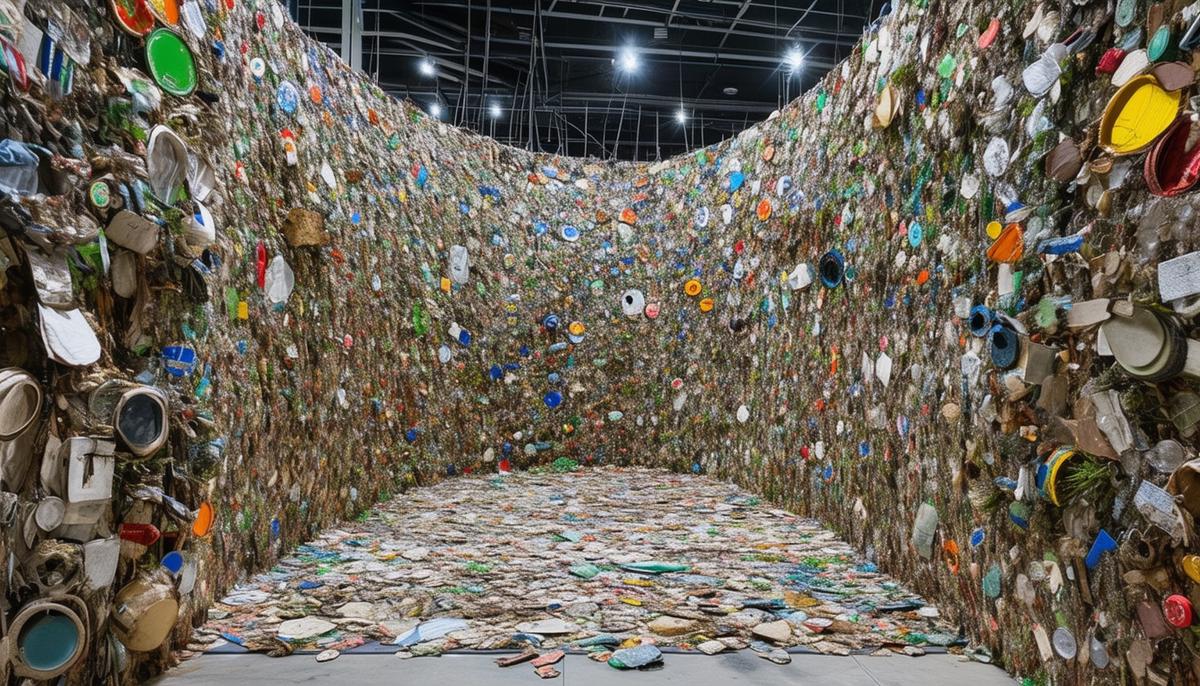
The Resurgence of Tangible Art Forms
Amid the impressive surge of digital mediums, there is a notable return to traditional, tangible art forms like painting and sculpture. This resurgence seeks to saturate the contemporary art scene with a rich sense of materiality and presence. It is a manifestation of the yearning for personal, physical engagement with art that resonates on a deeply human level. As we navigate myriad virtual experiences, the intrinsic value of an artwork one can touch, feel, and inhabit space with becomes increasingly precious.
This shift back towards classical modes sparks a thought-provoking discourse, questioning the essence of the art consumption experience. While digital art has brought about impressive technological advancements and boundary-pushing innovations, these largely intangible creations miss the tactile quality inherent in sculptures or canvases.
The digital fatigue setting in among audiences and artists has catalyzed a recalibration toward artworks with "tangible assurances." This does not imply that painted works or sculptures iterate within their traditional confines. Instead, there is an infusion of modern sensibilities and technical prowess that breathes new life into them. Individuals are drawing significant connections from physical art's substantiality against the more ethereal nature of digital creations, cherishing the physical presence as emotionally compelling and sensorially affirming.
These shifts back to tangible forms represent more than nostalgia; they embody a bridge between sensory interaction and psychological impact. Prestigious platforms such as Art Basel Miami Beach have been pivotal in showcasing why the tactile nature of artworks unsurprisingly garners renewed attention. Sculptures entice viewers into shared physical spaces for collective contemplation, while paintings radiate their textures and strokes, compelling onlookers to perceive them within the reckoning of their own reality.
This renaissance of tangibility shows conspicuous marks on the art market, influencing buyer preferences and aesthetic appreciations. It challenges the narrative that the digital art's prominence implies an obsolescence for classical forms. Instead, figureheads within the communal spheres of galleries and exhibitions bring these sensually rich artworks to the forefront, ensuring they receive equitable attention and appreciation as their digital equivalents.
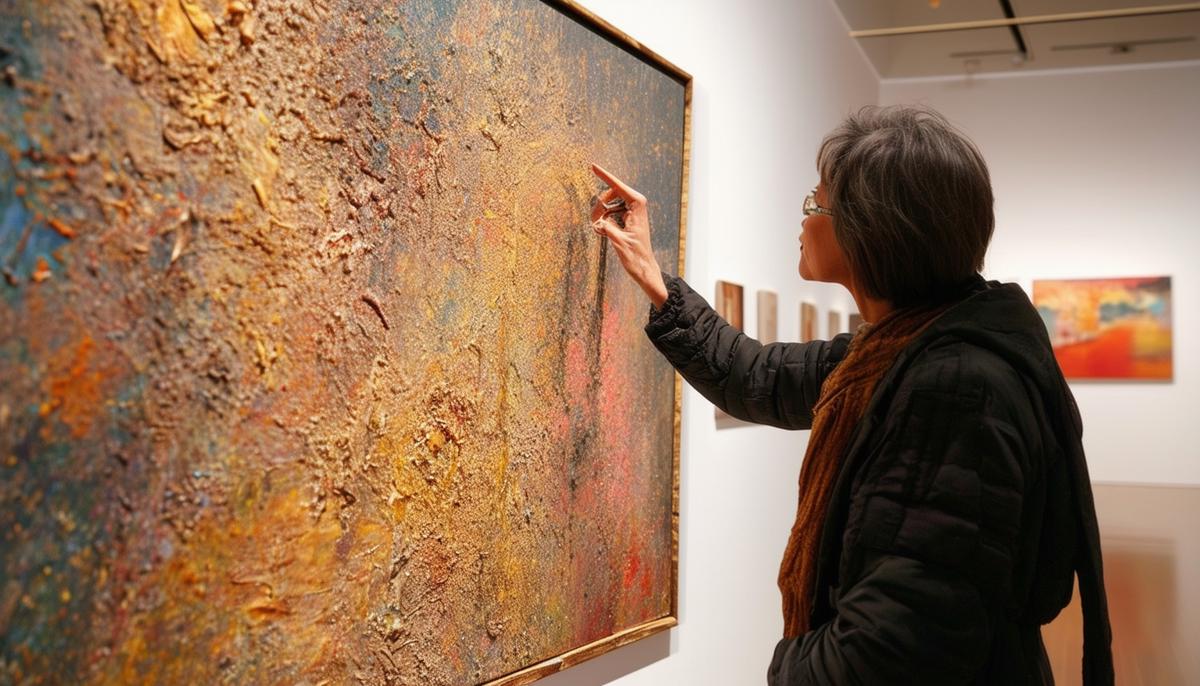
Diversity and Representation in Art
The art world is intensifying its commitment to amplify diverse voices, shaping the roster of contemporary creators and enriching the thematic depth of the art itself. This profound inclusivity is marking a significant turn in traditional narratives, with a notable ascension in the roles of artists from marginalized communities and a stage now substantially aware of gender parity and cultural diversity.
The rise of female creators and artists of various ethnic backgrounds is crucial. Where voices were once peripheral, they now command key conversations within the art community, setting the tone for the vanguard of contemporary art. Exhibitions across globe-spanning galleries and museums are curated to foreground figures such as:
- Bronwyn Katz
- Umico Niwa
- Jean-Michel Basquiat
This underscores a recalibration and renaissance of non-Western and female narratives in art.
This diversification within the artistic corpus mirrors societal advancements in awareness about systemic inequalities and imbues art with a varied palette that inextricably informs viewer interpretation. These artists carry distinctive experiences and perspectives which challenge and rearrange the canonical imperatives of the art world. As newer themes dominate the landscape, subjects of cultural identity, migration, gender issues, racial discourses, and sometimes hybridity of traditions stretch the fabric of conventional topics toward newly charted territories.
These evocations in diversity and representation foster a global conversation in alignment with societal shifts seeing increased focus on intersectionality. Exhibits such as the Venice Biennale and Documenta host displays effused with socio-political commentaries reflecting global issues, further garnering attention and empathy from an increasingly engaged audience that sees its own realities mirrored back in these visual dialogues.
Furthering this inclusivity, bold new initiatives like The Women's Art Center, spearheaded by emerging thought leaders in the industry, act as crucibles for nurturing talent and staging seldom heard voices. The rise of digital platforms simultaneously advances this inclusion curve. Online exhibitions break geographical barriers allowing artists who were once sequestered by their locale to participate vigorously on the international stage, connecting continents and curating within a digital quilt.
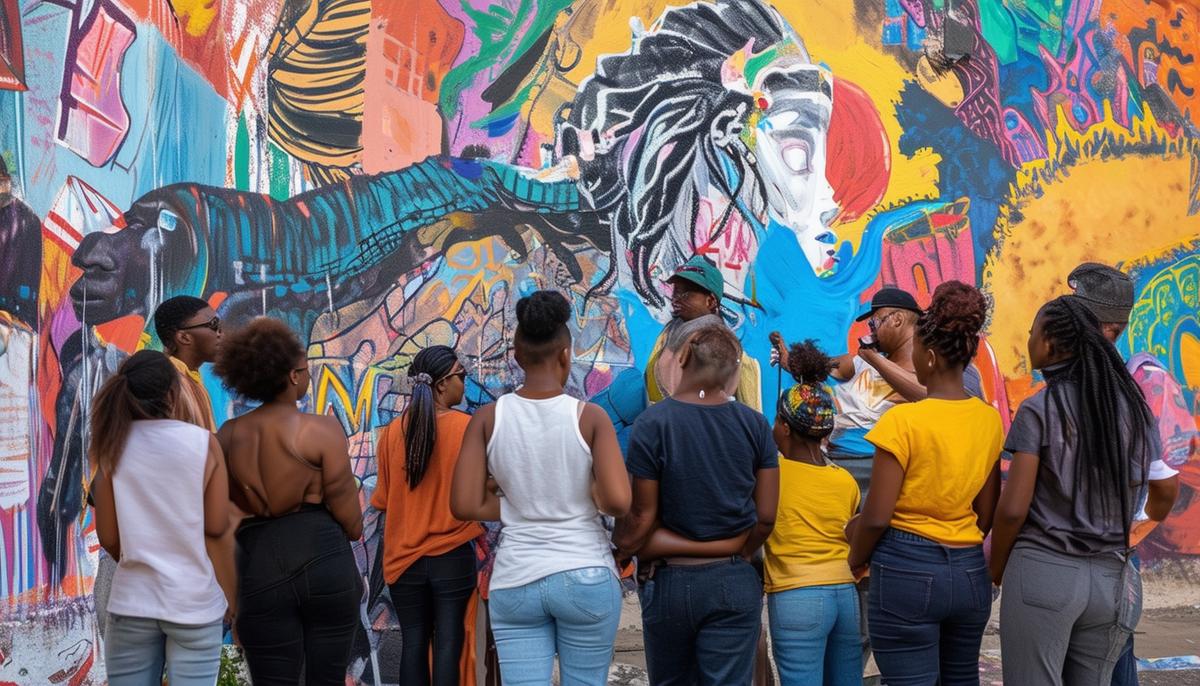
Investment and Market Trends
Given the dynamic interplay of innovation and heritage reshaping the contemporary art world, the economic dimensions naturally follow suit, with palpable shifts in how collectors and investors engage with the market. As these aficionados recalibrate their expectations in line with cultural and societal trends, a nuanced understanding of investment preferences emerges, highlighting the robustness of the art market amid global flux.
One marked shift is the burgeoning appetite for mixed media and interdisciplinary artworks, which have seen a substantial boost in perceived value. The expansive definition of what constitutes 'high art' has undergone reformation, allowing for once-peripheral methods and materials to take center stage as lucrative investment opportunities. Collectives featuring rejuvenated craftsmanship or postmodern digital creations have carved notable niches, captivating potential investors with their innovative appeal and exclusive standing.
Turning the lens on market segments reveals a resurgence in the appeal of classical paintings, albeit with a twist. Provocative contemporary pieces reflecting diversely sourced narratives and methods continue to fetch impressive sums. A record-setting auction sale of $139 million for Picasso's "Femme à la Montre" exemplifies the remarkably resilient demand for iconic 20th-century artists reinterpreted within the context of modern sensibilities.1
As environmental consciousness seeps deeper into societal fabrics globally, art reflecting sustainable themes is gaining moral and economic traction as well. Works conceptualized around eco-awareness or involving sustainable methodologies are receiving markedly increased valuations. Such trends pivot as crucial long-term economic strategies signifying the evolving tastes of conscientious patrons.
It must also be noted that as geopolitical scenes shift, political-themed artworks are surging in fascination and significance among sophisticated collectors. With global enormities frequently trailblazing narratives within canvases and installations, such artworks serve as timely reflections of global urgency, enhancing their appeal as heritage assets amidst an atmosphere rife with discerning investment magnates.
Investment-wise, collectors aren't merely purchasing art; more often, they are strategically aligning with causes, cementing legacies, spawning dialogues, or driving shifts within collector communities in webbed global dialogs. Such sociopolitically charged purchases underline emergent data suggesting that today's collectors view their acquisitions through prisms both aesthetic and allegoric, indicative of broader implications resonating in hues imbued by resolute ethos.
Amid spectral shifts in genres and mediums of prevailing interest, the intent of acquisitions has evidenced a discernable transition from whimsical collecting toward considered long-term asset accruement. Art newcomers and seasoned mavens identify with art's tangible magnitudes and its promise of enduring through fluctuating landscapes—a gesture encircling humanity's undying engagements with interpreted worlds.
As we look toward the horizon beyond 2024, analysts intimate converging pathways between digital innovations and sustainable legacies, brushing a vivid tableau of a boldly reinvented art market. One pulsating vigorously at the vanguard of collective civilizational syllabuses, where every transaction transcends transactional borders to celebrate, critique, or alter human engagements molded by ever-eroding epochal delineators.
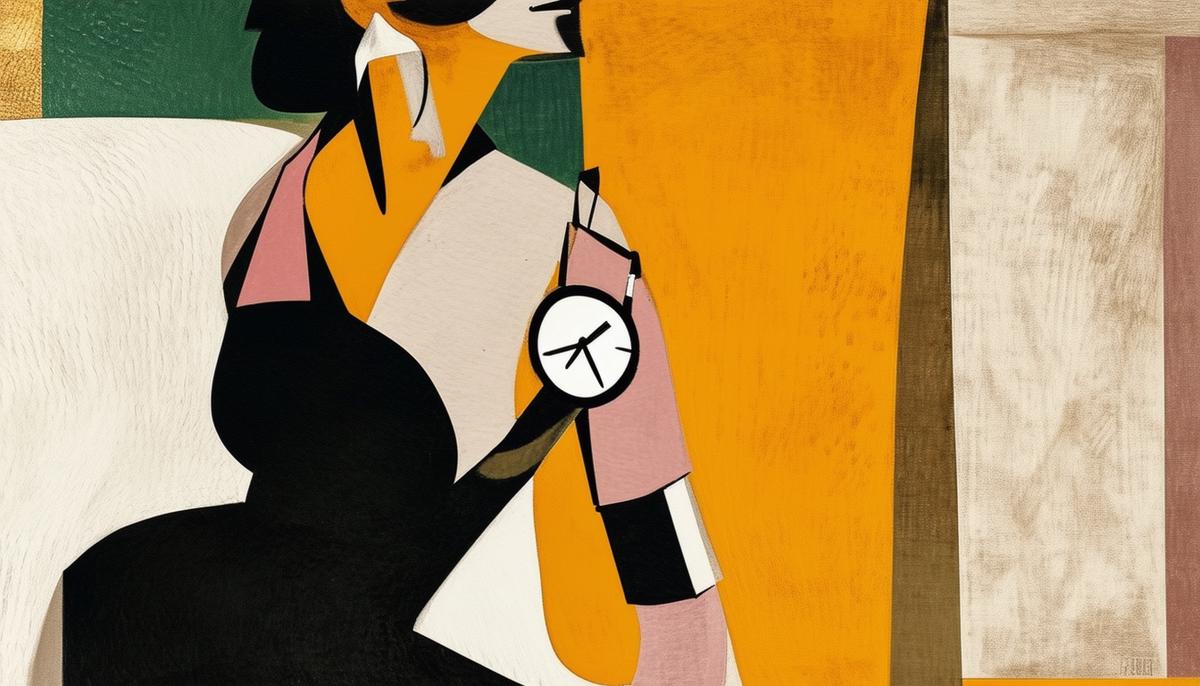
Political and Social Themes in Art
In this progressive era, artists are increasingly using their creative outpourings to spotlight crucial issues like environmental distress, social injustice, and political volatility. This application of art as a conduit for political and social commentary isn't new, but it has intensified in response to turbulent times.
Environmental art has become a major arena for ecological activism. Artists employ repurposed materials and transformative techniques to encapsulate the challenges besieging our natural world. Their works carry an undercurrent of urgency, translating a rallying cry for conservation and reformed human engagement with nature.
Social composition canvases mirror tales of disenfranchised communities, amplifying voices from the margins. These artworks depict the real-world impacts of policy decisions on marginalized populations, human rights violations, and the resilience in everyday struggles. Their canvases become protest signs shaped in colors and contours—a visual storytelling coursing through the empathy veins of spectators.
With intensifying political climates, many artists have positioned their galleries as battlegrounds of discourse. They create pieces interpreting government intrigues or critiquing authoritarian fabrics obfuscating democracies. Such exposures are crafted to leverage dialogue, provoke thoughts, and stimulate political literacy.
A new legion of artistic activists is harnessing the power of digital platforms to propagate their confrontational and enlightenment campaigns globally. They capture hearts, redirect views, and download controversies into the cache of public consciousness nearly in real-time.
As artwork continues to evolve into a broader scenario of communicative activism across multi-genre mediums, it forces society to reflect on its prisms and decrypt imageries akin to socio-political scripts. Art proves an animate activism canvas, impacting civil pulses and espousing equality modulations.
In conclusion, as long as societal pivots sway within human realms, art remains a vibrant valor in the vanguard of permanent revolutions. Artists serve as envoyed artisans, scripting heritage imprints aligned emotively against canvases, endorsing discursive epochs, and converging interventionist crafts—principally charting humanity's kaleidoscopic causeways.
The power of art as a catalyst for social and political change is evident in numerous examples throughout history, such as:
- Pablo Picasso's Guernica, which depicted the horrors of the Spanish Civil War and raised awareness about the atrocities committed1
- The AIDS Memorial Quilt, a collaborative project that mourned the lives lost to AIDS and advocated for increased research and support for those affected2
- Banksy's thought-provoking street art, which often critiques consumerism, war, and social inequality3
